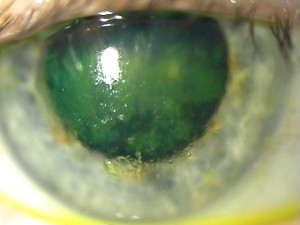Dry Eyes
Dry Eyes
Ohio Eye Alliance is a center of Excellence for Dry Eye Disease. Our Doctors have had additional training in diagnosing and treating dry eyes with multiple modalities. Dry Eye Syndrome is a number of separate conditions and not just one type of problem.
Dry eye syndrome is one of the most common problems treated by eye care professionals. This is because the symptoms can cause blurred vision and irritation. This can lead to decreased ability to perform common activities that require your visual attention, including reading, using a computer, or driving.
Signs and symptoms can include:
- Excessive watering of the eyes
- Stinging, burning or scratchy sensation
- Feeling of a foreign substance in the eye
- Stringy mucus in or around eyes
- Increased irritation from smoke or wind
- Eye fatigue from reading or driving

Tears
Your tear film protects and lubricates your eyes. It also helps clear your eyes of debris each time you blink. Tears are made up of three layers. The inner mucus layer coats the cornea, the front surface of the eye. This forms a foundation for the tear to adhere to the eye. The middle watery layer provides nutrition, oxygen and moisture to the cornea. The outer oily layer seals the tear film and helps prevent the tears from evaporating. Tears are formed by several glands around the eyes. The lacrimal gland produces the watery layer. Several small meibomian glands produce the oily layer. With each blink tears are spread over the eye and excess is flushed into the tear ducts.
Excessive tearing can also be a symptom of dry eye syndrome. Some tears are produced by injury, irritation or emotion. These tears are called reflex tears. They contain little oil or mucus, and do little to soothe the eye. This is why someone with watery eyes may still feel irritation. Often more reflex tears are produced in response to the irritation, overwhelming the tear ducts and overflowing the eyes.
Causes
Dry eyes are caused by a variety of reasons that disrupt the healthy tear film. Your tear film has three layers: fatty oils, aqueous fluid and mucus. This combination normally keeps the surface of your eyes lubricated, smooth and clear. Problems with any of these layers can cause dry eyes.
Reasons for tear film dysfunction are many, including hormone changes, autoimmune disease, inflamed eyelid glands or allergic eye disease. For some people, the cause of dry eyes is decreased tear production or increased tear evaporation.
* credit Mayo Clinic
Treatment
*Click the links below for more information
-
Artificial Tear Drops
The first step in treatment is usually an artificial tear to give temporary relief. Many brands are available over-the-counter, and often come in a preservative-free formulation for those sensitive to preservatives. Artificial tears should be used on a regular basis, with the ability to add more drops on an as-needed basis. Often patients will try several different brands to find the one that works best for them. Artificial tear ointments are also available. They provide a thicker, and therefore longer lasting form of relief, but can cause blurriness upon instillation. Many people reserve ointments for overnight use. Steroid or allergy drops may be prescribed as well, depending on the cause behind your dryness.
There are 3 different prescription drops for Dry Eye.
*Click the links below for more information -
Restasis®,Xiidra®, Cequa®
Click the links below for more information:
- Restasis*
*If artificial tear use three to four times a day does not relieve the symptoms of dry eye syndrome, your doctor may prescribe cyclosporine (Restasis®), for chronic dry eyes. Restasis® reduces inflammation on the eye surface and helps your eye produce healthier tears. This medication requires faithful insertion of the drop twice per day often for an extended period of time. Because this drop requires up to a six-month period to fully relieve the symptoms of dry eye, it is very important that you continue the use as directed by your doctor. - Xiidra
- Cequa
- Restasis*
-
Punctal Plugs
Another approach is to conserve as much of the natural tears as possible. This is done by partially or completely closing the tear ducts. Tiny plugs inserted into the puncta conserves natural and artificial tears. These plugs can be temporary, and may be removed. In more severe cases, the puncta can be permanently closed through a cautery procedure.
-
Lid Treatments
If any lid problems are present, you may require surgery to correct the lid dysfunction. If the lid is inflamed by blepharitis, a cleansing regimen and warm compresses are often prescribed. In more severe cases short-term antibiotic drops, ointment or oral medication may be necessary.
-
Supplements
Recently, attention has been drawn to the use of fatty acids to naturally balance your bodys oil production. These studies emphasize the use of flax seed oil and omega 3 fish oils. The effectiveness of this therapy is not yet proven. Although many patients have seen improvement in symptoms of dry eye after taking these.
What Can I Do?
Taking these simple steps can help you control your dry eye syndrome:
- Avoid air blowing into your eyes. Don’t direct air vents, heaters, fans or hair dryers towards your face.
- Wear glasses, sunglasses or goggles to reduce the effects of wind and water on your eyes.
- Maintain 30-50% humidity in your home.
- Hydrate your body by drinking lots of water. Reducing your caffeine intake can also help.
- Avoid rubbing your eyes. The more you rub, the more irritated they will become.
- Use eye drops BEFORE your eyes feel irritated. This will prevent your reflex tearing.
- Remember to blink. While reading or working on the computer take occasional breaks. If you consciously remember to blink, you will assist your natural tear film in spreading evenly.
FOLLOW YOUR DOCTORS DIRECTIONS. Even if your eyes start feeling better, continue to use your drops and/or medications as directed.

